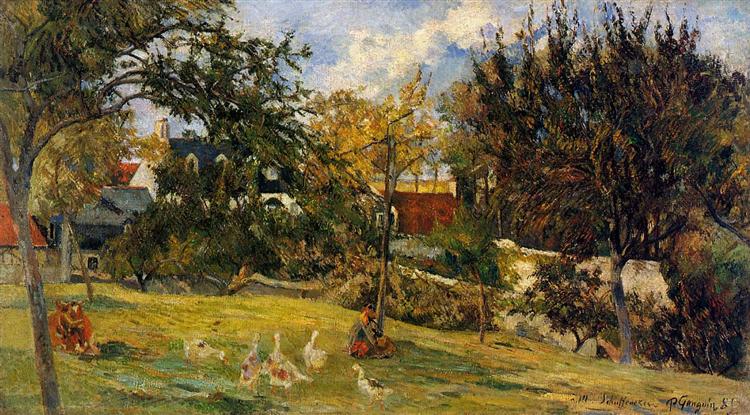Description
Paul Gauguin's Geese in the Meadow (1885) stands as a fascinating example of the artist's distinctive approach during his early years in painting. In this painting, Gauguin displays his ability to fuse naturalistic observation with a sense of the decorative, using a visual language that anticipates the symbolism that would characterize his later work.
At first glance, the composition is captivatingly simple. The scene is dominated by a vast meadow stretching out under a slightly overcast sky, in which angels of light appear as imaginative interventions in the atmosphere. In the foreground, a group of geese are grazing, depicted with a remarkable use of colour and form that captures both their essence and their surroundings. The geese, with their softly hued feathers, stand out against the vibrant green of the grass, which not only underlines the richness of Gauguin’s palette but also establishes a dialogue between fauna and landscape.
The colors in Geese in the Meadow are a fundamental part of its visual impact. Gauguin uses a palette that oscillates between deep greens and warm ochres, reflecting careful attention to the interplay between light and shadow, and suggesting the coolness of the meadow in the afternoon. This color choice is not simply aesthetic; instead, it is integrated into the narrative of the work, lending a sense of serenity and tranquility that invites the viewer to reflect on the connection between living things and their environment.
The absence of human figures in the composition is notable. Unlike other contemporary works by Gauguin that incorporate human beings into the natural scene, here the geese are the only protagonists. This decision could be interpreted as a conscious attempt to highlight the harmony of nature in its pure state, far from human intervention. Such an approach can also be considered a precursor to his interest in the themes of isolation and the search for beauty in the elemental, themes that would later appear in his work in Tahiti.
However, the legacy of Geese in the Prado is not limited to its composition and technique. This work is part of a series of explorations that Gauguin carried out on his way to the post-impressionist movement. The works from this early stage are crucial to understanding his stylistic evolution, in which he began to distance himself from the conventions of impressionism, seeking a more personal form of artistic expression.
Studying Geese in the Meadow, one can sense that Gauguin is not only capturing a snapshot of pastoral tranquility, but is also establishing a bridge to his future works, in which symbolism and emotionality would play a central role. The integration of form and color, as well as the exploration of nature and animal life, show an artist in the process of discovery, whose search for meaning in painting was just beginning.
Thus, "Geese in the Meadow" is not just a depiction of geese in a meadow; it is a work that encapsulates Gauguin's evolution and a testament to his ongoing search for new forms of art that would resonate beyond his time, where nature becomes a mirror of human emotions. Ultimately, this painting is an invitation to contemplate the beauty of the everyday, a theme that Gauguin would explore in depth in the works that would catapult him into art history.
KUADROS ©, a famous painting on your wall.
Hand-made oil painting reproductions, with the quality of professional artists and the distinctive seal of KUADROS ©.
Painting reproduction service with satisfaction guarantee. If you are not completely satisfied with the replica of your painting, we will refund 100% of your money.

